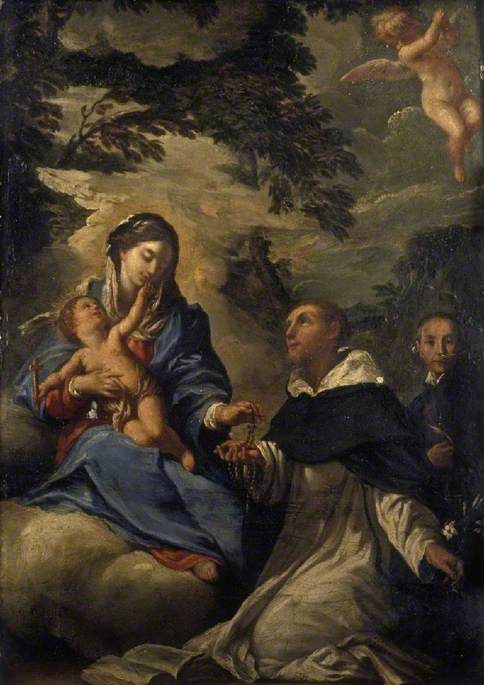
Sometimes disputed, but a devoted tradition for many, St. Dominic’s reception of the modern-day rosary from the Virgin Mary has stood the test of time. Historically speaking, the rosary itself has evolved over time due to varying levels of literacy, stations in life such as the monastics versus the laity, and the evolution of the prayers themselves. The saying of 150 Pater Nosters or Aves (referencing the Ave Maria) has been long held as the origin of the rosary. Even Dominicans, do not dispute this. However, the Marian Psalter, or the rosary as we refer to it today, was given to St. Dominic by our Blessed Mother. For further information in this regard, I direct you to a wonderfully written article in defense of Holy Father Dominic and the rosary written by Father Paul Duffner (OP), a friar from the western province of the United States, who died in 2018 at the age of 103, entitled “The Rosary & St. Dominic: In Defense of a Tradition” .
The inspiration for this article was not only Fr. Duffner’s article but also an article written by Father Cyril Dore (OP), when he was a student brother. Fr. Dore was a friar of the eastern province in the United States, was the seventh president of Providence College, and died in 1984. His article is entitled “The Popes and The Rosary” .
In his article, Fr. Dore mentions the long list of papal devotees of the Marian Psalter. He writes, “Among the most prominent of the early proclamations on Rosary devotion, are those of Urban IV, who wore the fisherman’s ring from 1261 to 1264, and John XXII, whose pontificate extended from 1316 to 1334. We know that these two Popes confirmed the Rosary devotion from the testimony of later Popes.” He goes on to say, “The fact that Urban IV and John XXII are mentioned by later Popes cannot be rated as a gratuitous statement. Anyone conversant with the strict rules of the Papal Chancery must know that at the time the bulls of Sixtus V and Benedict XII were drawn up, the composer of these acts either had the documents of Urban IV and John XXII at hand, or the authentic record of the same.” For those who are seeking further authenticity of this statement, Fr. Dore mentions “In passing, we might call attention to the fact that Urban IV was a contemporary of St. Dominic.” as well as, “ ‘… after lauding the works of the Sons of Saint Dominic for their untiring efforts in spreading this devotion, Alexander VI goes on to say that “this Salutation, extends throughout the whole Dominican Order and includes both the living and the dead; that it was through the merits of the Blessed Virgin Mary and the zealous preaching of this devotion by Saint Dominic that the whole order of the world was preserved.’”
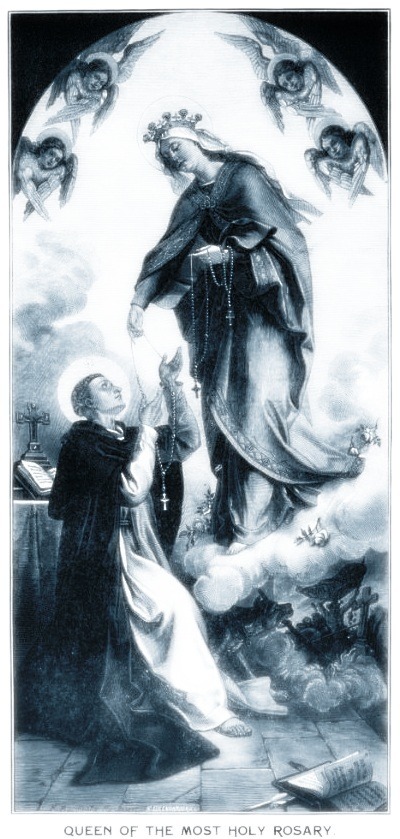
St. Dominic, the founder of the order of Friar Preachers, having recourse to the Blessed Virgin in order to stem the flood of the Albigensian heresy, which was spreading itself like a plague over many countries, but especially over France, instituted, by special revelation from her, in the year 1206, and afterwards very effectually promulgated, the devotion of the holy Rosary, which ever since has produced now for many ages the most marvellous results in the Christian world.
The Raccolta (circa 1857)
The painting Madonna of the Rosary by Lorenzo Lotto depicts St. Dominic receiving the rosary by the Blessed Virgin Mary. It was commissioned by the Confraternity of the Rosary in the Italian town Cingoli and is an altarpiece for the church of San Domenico. The images of St. Mary Magdalene (co-patroness of the Order of Preachers) is depicted behind St. Dominic along with a Dominican friar, either St. Thomas Aquinas or St. Vincent Ferrer. On the right side of the painting is St. Catherine of Siena and St. Peter of Verona. Within the Tree of Life image are the 15 original mysteries of the rosary.
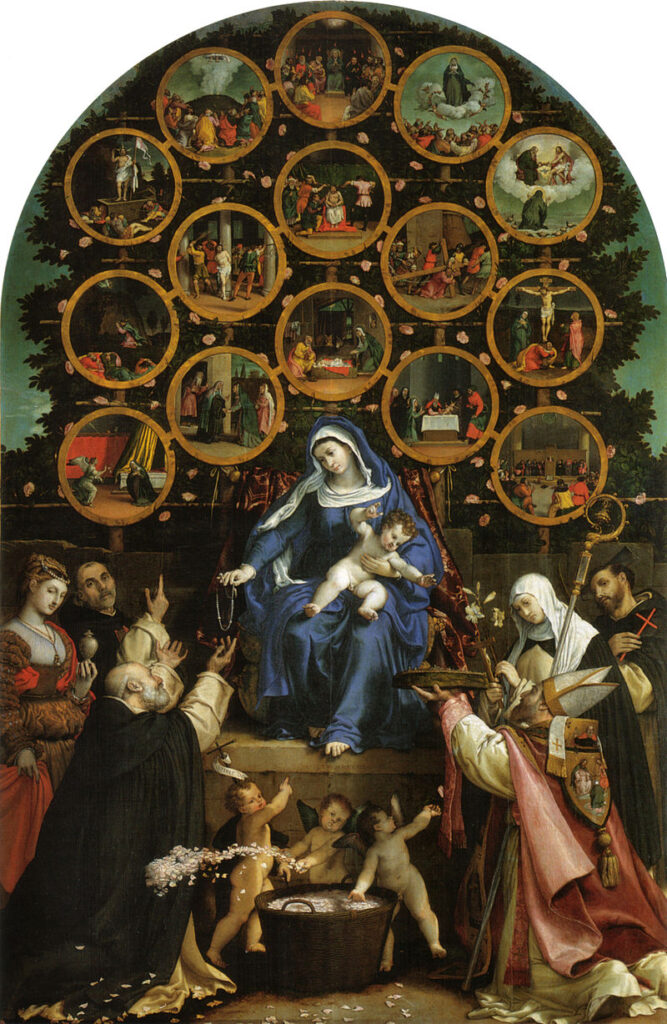
What is the depth of papal devotion to the rosary? According to Father Andrew Mary Patrick Skelly, a western province Dominican friar who died in 1938, there were (at one time) 214 bulls, decrees, and encyclicals written by 39 popes all proclaiming a devotion to the rosary, with at least 10 of those attributing the origins of the Marian Psalter to St. Dominic’s reception from the Virgin Mary. Sadly, much of the papal documents were lost in historical events such as the Reformation. Still, much remains, and we do have the small references to the lost documents in more contemporary writings, papal and otherwise. I encourage those interested to read the booklet “St. Dominic and The Rosary or Was He Its Founder?” by Fr Skelly. This booklet is a compilation of writings as they relate to a public dispute with a British Jesuit priest that unfolded in a periodical entitled “The Catholic Sentinel”. And thanks to Fr. Skelly, the contents of the actual articles are appendices at the end of the booklet.
Pope Benedict XV in his encyclical Fausto Appendente Die (an entire encyclical dedicated to Holy Father Dominic), he pays homage to the Founder of the Order of Preachers by saying, “In this is amply shown the third quality We have noted in Dominican preaching: a most zealous piety towards the Mother of God. It is said that the Pontiff knew by Divine revelation of the victory of Lepanto achieved at that very moment when through the Catholic world the pious sodalities of the Holy Rosary implored the aid of Mary in that formula initiated by the Founder of the Friar Preachers and diffused far and wide by his followers. Loving the Blessed Virgin as a Mother, confiding chiefly in her patronage, Dominic started his battle for the Faith. The Albigenses, among other dogmas, attacked both the Divine maternity and the virginity of Mary. He, attacked by them with every insult, defending to the utmost of his strength the sanctity of these dogmas, he invoked the help of the Virgin Mother herself, frequently using these words: “Make me worthy to praise thee, Sacred Virgin; give me strength against thine enemies.” How pleased was the Heavenly Queen with her pious servant may be easily gathered from this, that she used his ministry to teach the Most Holy Rosary to the Church, the Spouse of her Son; that prayer which, being both vocal and mental, in the contemplation especially of the mysteries of religion, while the Lord’s Prayer is fifteen times repeated together with as many decades of the Hail Mary, is most adapted to fostering widely piety and every virtue. Rightly, then, did Dominic order his followers, in preaching to the people, to inculcate frequently this manner of prayer, the utility of which he had experienced. He knew, on the one hand, Mary’s authority with her Son to be such that whatever graces he confers on men she has their distribution and apportionment. On the other hand, he knew that she is of a nature so kind and merciful that, seeing that it is her custom to succor the miserable of her own accord, it is impossible she should refuse the petitions of those who pray to her.”
Pope Pius XI gives a nod to St. Dominic with this statement “This practice of piety, Venerable Brethren, admirably diffused by St. Dominic, not without the heavenly suggestion and inspiration of the Virgin Mother of God, is without doubt easy for all, even for the ignorant and the simple. But those wander from the path of truth who consider this devotion merely an annoying formula repeated with monotonous singsong intonation, and refuse it as good only for children and silly women!” in his encyclical Ingravescentibus Malis.
Pope Leo XIII wrote 12 encyclicals on the rosary, often near the month of October, which is dedication to this Marian devotion. Paragraph three of his encyclical Supremi Apostolatus Officio states, “This devotion, so great and so confident, to the august Queen of Heaven, has never shone forth with such brilliancy as when the militant Church of God has seemed to be endangered by the violence of heresy spread abroad, or by an intolerable moral corruption, or by the attacks of powerful enemies. Ancient and modern history and the more sacred annals of the Church bear witness to public and private supplications addressed to the Mother of God, to the help she has granted in return, and to the peace and tranquillity which she had obtained from God. Hence her illustrious titles of helper, consoler, mighty in war, victorious, and peace-giver. And amongst these is specially to be commemorated that familiar title derived from the Rosary by which the signal benefits she has gained for the whole of Christendom have been solemnly perpetuated. There is none among you, venerable brethren, who will not remember how great trouble and grief God’s Holy Church suffered from the Albigensian heretics, who sprung from the sect of the later Manicheans, and who filled the South of France and other portions of the Latin world with their pernicious errors, and carrying everywhere the terror of their arms, strove far and wide to rule by massacre and ruin. Our merciful God, as you know, raised up against these most direful enemies a most holy man, the illustrious parent and founder of the Dominican Order. Great in the integrity of his doctrine, in his example of virtue, and by his apostolic labours, he proceeded undauntedly to attack the enemies of the Catholic Church, not by force of arms; but trusting wholly to that devotion which he was the first to institute under the name of the Holy Rosary, which was disseminated through the length and breadth of the earth by him and his pupils. Guided, in fact, by divine inspiration and grace, he foresaw that this devotion, like a most powerful warlike weapon, would be the means of putting the enemy to flight, and of confounding their audacity and mad impiety. Such was indeed its result. Thanks to this new method of prayer-when adopted and properly carried out as instituted by the Holy Father St. Dominic-piety, faith, and union began to return, and the projects and devices of the heretics to fall to pieces. Many wanderers also returned to the way of salvation, and the wrath of the impious was restrained by the arms of those Catholics who had determined to repel their violence.” In the same document, in paragraph seven “Our need of divine help is as great today as when the great Dominic introduced the use of the Rosary of Mary as a balm for the wounds of his contemporaries.” He continues in paragraph eight where he mentions “That great saint indeed, divinely enlightened, perceived that no remedy would be more adapted to the evils of his time than that men should return to Christ, who “is the way, the truth, and the life,” by frequent meditation on the salvation obtained for Us by Him, and should seek the intercession with God of that Virgin, to whom it is given to destroy all heresies. He therefore so composed the Rosary as to recall the mysteries of our salvation in succession, and the subject of meditation is mingled and, as it were, interlaced with the Angelic salutation and with the prayer addressed to God, the Father of Our Lord Jesus Christ. We, who seek a remedy for similar evils, do not doubt therefore that the prayer introduced by that most blessed man with so much advantage to the Catholic world, will have the greatest effect in removing the calamities of our times also.”
To conclude this brief introduction to the papal perspective of St Dominic and the rosary, I would like to share with you the words of Pope Leo XIII, a prolific author of papal documents dedicated to this Marian devotion. In his encyclical Magne Dei Matris, dated September 8, 1892, he penned “The well-known origin of the Rosary, illustrated in celebrated monuments of which we have made frequent mention, bears witness to its remarkable efficacy. For, in the days when the Albigensian sect, posing as the champion of pure faith and morals, but in reality introducing the worst kind of anarchy and corruption, brought many a nation to its utter ruin, the Church fought against it and the other infamous factions associated with it, not with troops and arms, but chiefly with the power of the most holy Rosary, the devotion which the Mother of God taught to our Father Dominic in order that he might propagate it. By this means the Church triumphed magnificently over every obstacle and provided for the salvation of her children not only in that trial but in others like it afterward, always with the same glorious success. For this reason, now, when human affairs have taken the course which We deplore, bringing affection to the Church and ruin to the State, all of us have the duty to unite our voice in prayer, with like devotion, to the holy Mother of God, beseeching her that we too may rejoice, as we ardently desire, in experiencing the same power of her Rosary.”
Sacred Art Images of St. Dominic And The Rosary
Below is a small sampling of images depicting St. Dominic receiving the rosary from the Blessed Virgin Mary.
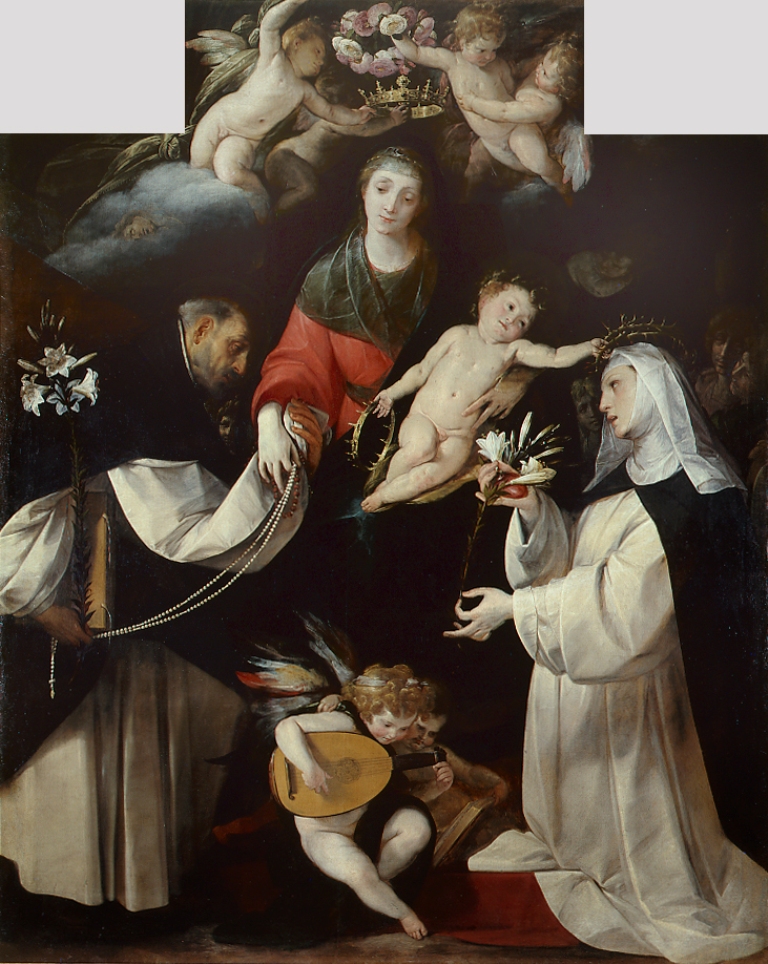
The artist is unknown, but might be Cerano (Giovan Battista Crespi).
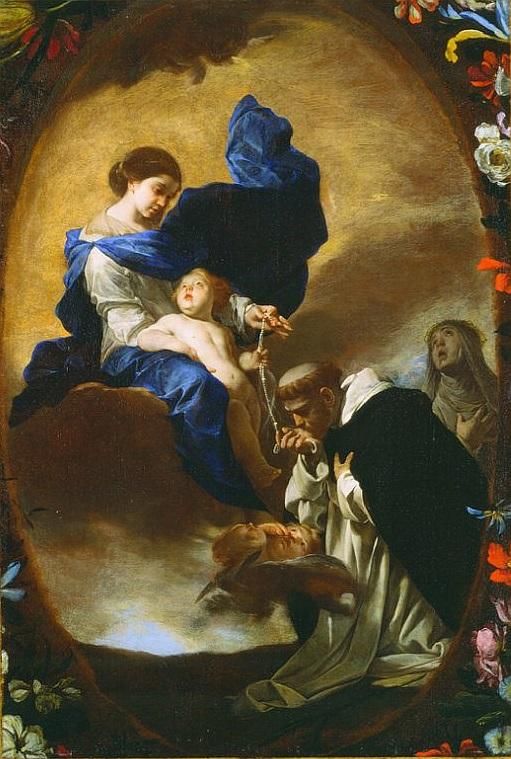
by Bernardo Cavallino
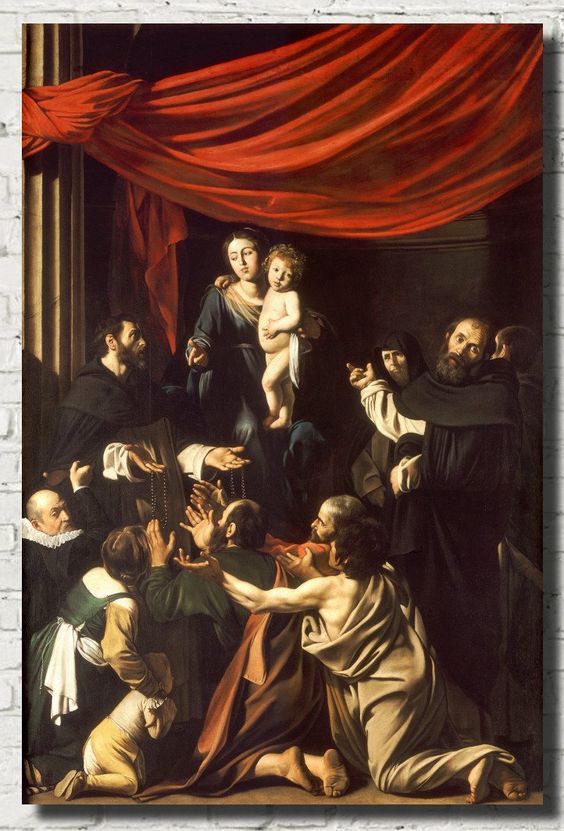
by Michelangelo Merisi da Caravaggio
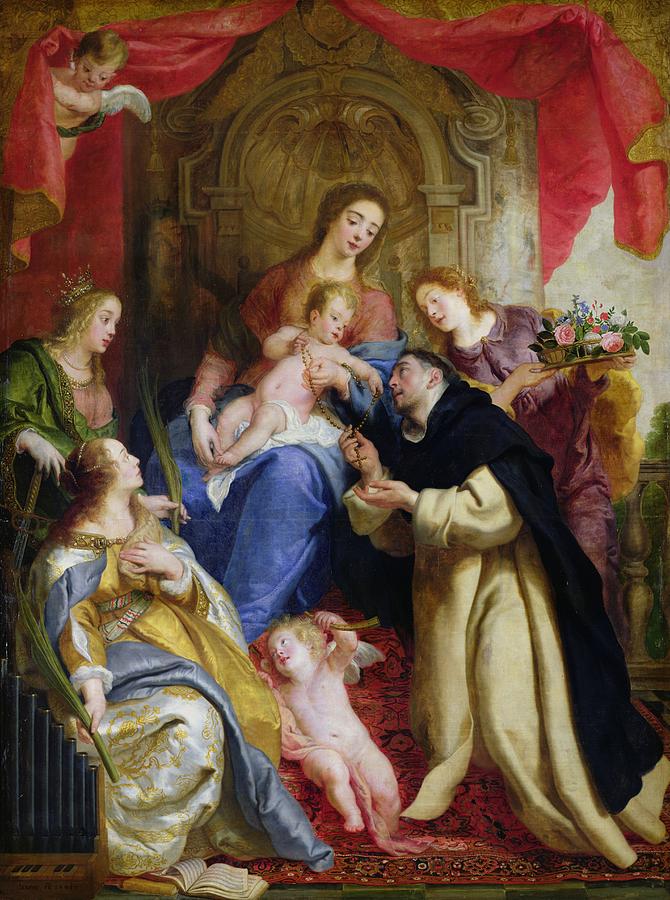
by Gaspar de Crayer
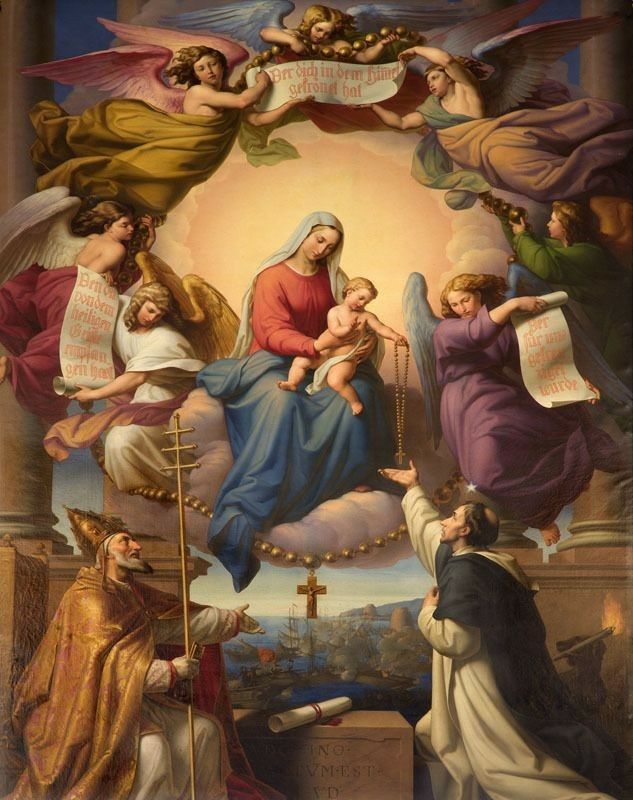
(Artist Unknown)
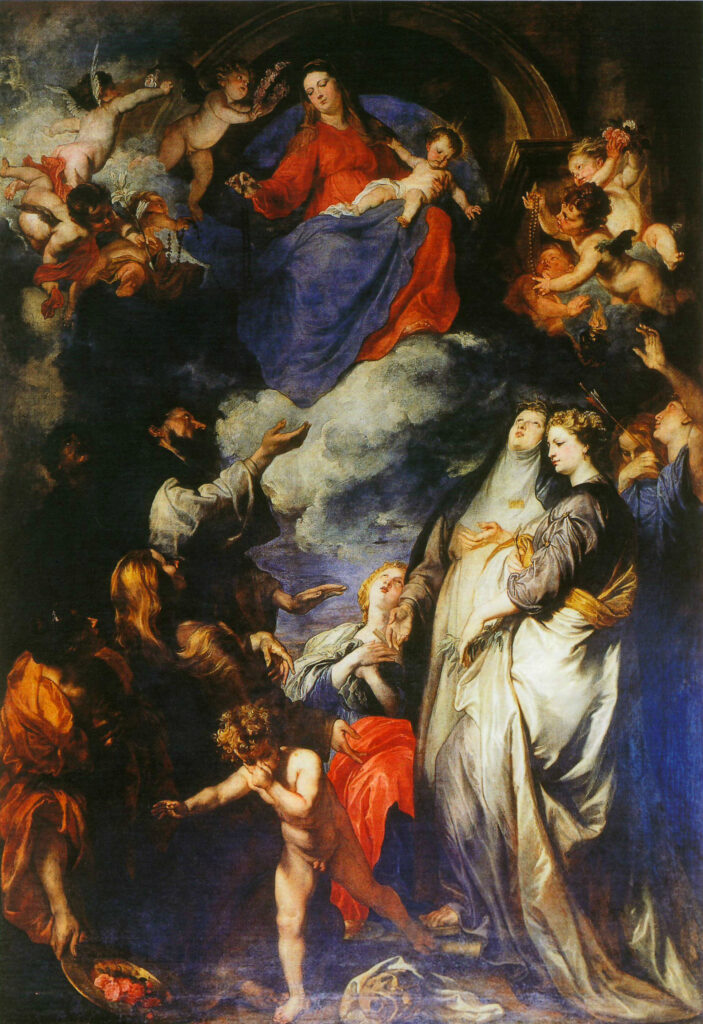
by Anthony van Dyck
Shrines Dedicated to St. Dominic And The Rosary
Below is a sampling of shrines around the world dedicated to St. Dominic and his reception of the rosary from the Blessed Virgin Mary.

Special thanks to Fr. Lawrence Lew for providing the beautiful photo above as well as a link to a virtual tour of the church, which as he mentioned to me, is also the first in the world to have altars and chapels dedicated to every mystery of the rosary.
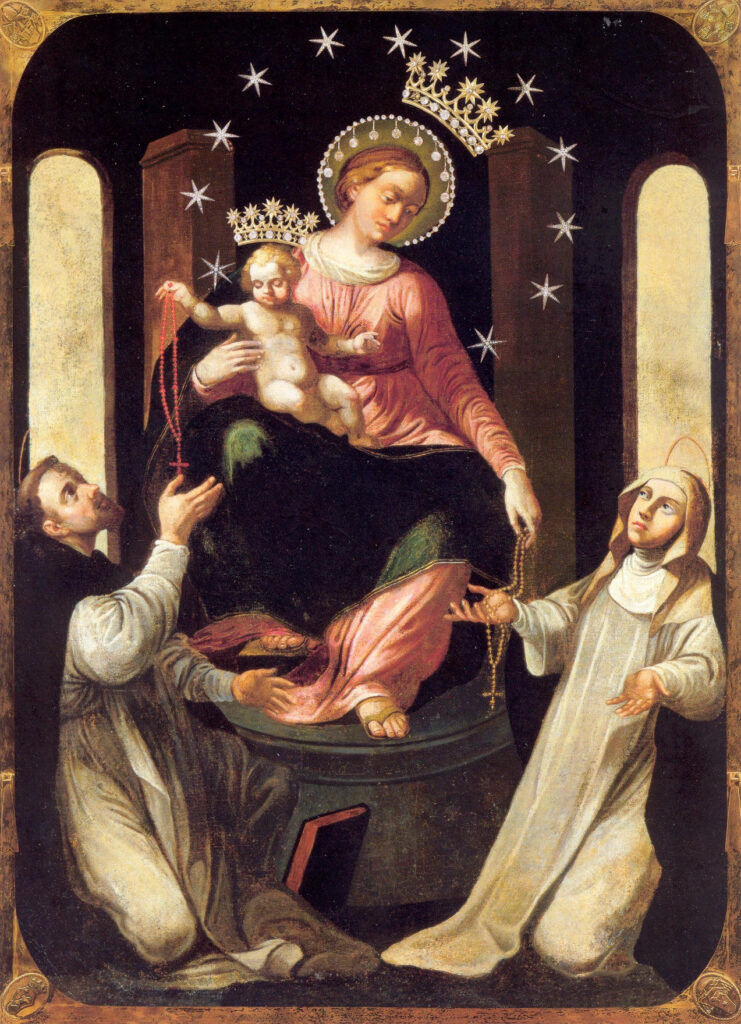
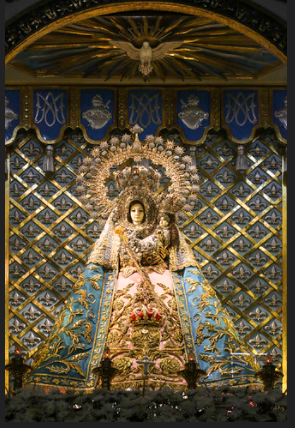
Additional Sources
Below is a listing of additional sources as they related to St. Dominic receiving the rosary from the Blessed Virgin Mary
The New Rosary Indulgence and Saint Dominic ; Br. Nicholas Walsh, OP , Dominicana Journal, 1927
The Virgin Presenting The Rosary to St. Dominic ; Painting by Antonio Palomino (d. 1726), Seattle Art Museum
Consueverunt Romani ; Pope Pius V, 1569
Octobri Mense ; Pope Leo XIII, September 22, 1891
Laetitiae Sanctae Pope Leo XIII, September 8, 1893
